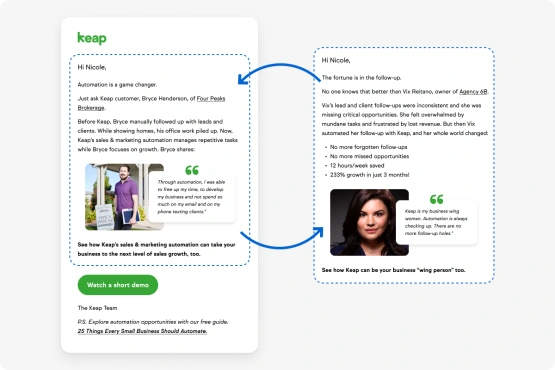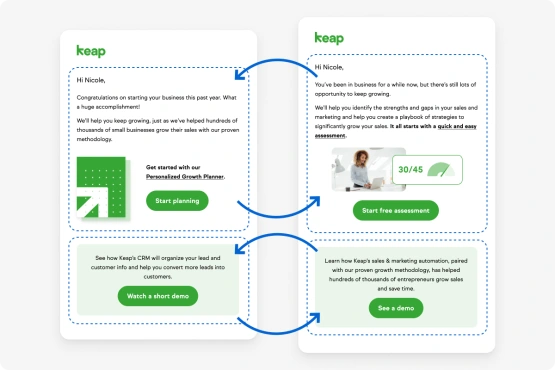As a customer, one of the biggest turnoffs about a company is irrelevant messaging. Like an email mentioning fall weather when you’re still sweltering in 100+ degree temps in Phoenix. Or a direct mail flier highlighting cat food specials when you have three dogs.
But you’ve also (hopefully) experienced some spot-on messaging that makes you feel known — where recommended resources or products are perfect for you, customer stories are relatable and you’re compelled to take the next step with the company.
Creating marketing materials personalized to an individual may sound daunting. But I promise you: with the right dynamic content strategy and tools, you can make your marketing so much more impactful without a ton of ongoing effort.
What is dynamic content?
Dynamic content is content that varies based on the individual, creating a unique experience for the user based on their behaviors and interests. We’re talking about more than including a customer’s name in an email or pulling in data via a merge field.
It means tailoring full sections of content, calls to action (CTAs), forms, recommendations and more to the individual. (But it’s ok to start with one of these and add in more dynamic components over time.)
Why should you use dynamic content?
Relevant messaging not only helps your leads and customers feel understood and appreciated, it also help you improve sales in these ways:
- By guiding each lead to their next step in your sales funnel, you’ll see better lead conversion rates.
- By serving up relevant new products and upsell/cross-sell options, you’ll see greater average order values and customer lifetime value.
Where can you use dynamic content?
Most marketing channels offer opportunities to incorporate dynamic content.
You can set up variable sections of content containing different copy, images and CTAs to show to specific segments of your database. You’ll specify which content blocks align with each segment when setting up the email in your email tool. Each recipient may receive a different email based on their unique combination of past purchases, interests, preferences, etc.
Webpages
It’s possible to serve up personalized CTAs, images, discounts and messaging on your website by implementing dynamic content. For example, you might want to offer a discount to leads who have returned to your site several times but haven’t purchased, or recommend specific products based on their purchase history.
Website chat
Using cookies and data stored in your small business CRM platform, you can tailor your chat communications with site visitors. Specific chat playbooks can fire based on the number of times a lead has visited your website or key pages (like your pricing or consultation page), their industry, actions they’ve taken or the amount of time since their last visit to your site.
Ads
By loading lists or integrating your CRM with your social media platforms, you can tailor ads to segments of leads and/or customers via social media feeds. For example, if a lead has demoed your product but hasn’t purchased it, you can retarget them on social media with a special offer. Or if they’ve downloaded a lead magnet, you may want to encourage them to watch a case study or demo video via a retargeting ad.
Forms and progressive profiling
It can be super annoying for a site visitor to be asked for data they’ve already provided. With dynamic content, you can move past the basics when a customer comes back to your site, perhaps asking what types of content they are interested in or what industry they’re in. It’s a win-win: the customer isn’t bombarded with the same form every time, and you gather data to help further personalize future content for them.
What are the steps for creating impactful dynamic content?
Now that you’ve had time to think through the impact dynamic content can have in your business, let’s dig into the implementation steps.
1. Develop your segmentation strategy
As Dr. Steven R. Covey shared in The 7 Habits of Highly Effective People, “Begin with the end in mind.” To successfully implement dynamic content, you need to outline what segmentation will help you share relevant content with the right audience.
You may start with segmenting by geography, industry and/or leads vs. customers. As you progress in your dynamic content journey, you might add in factors like whether they’ve scheduled a consultation or whether they’re struggling with pain point A vs. pain point B.
The segmentation you’ve outlined determines what data points you’ll need to capture.
2. Collect data in your CRM
Building robust lead and customer records in your CRM allows you to create personalized messaging across all channels. You can capture every key action and communication for every lead and customer in one place using a small business CRM like Keap.
Get started collecting key data with these steps:
- Capture basic info like name and email address during the initial interaction with a lead.
- Add more information to each lead record through progressive profiling. Ask for and capture more specific information about your leads through ongoing interactions. This could include pain points your lead is struggling with or the industry they’re in.
- Enhance each lead record with behavior-based data like which links they’ve clicked. You can even use tags to keep track of interests. For example, if a lead clicks on a resource about creating podcasts, you can add a “podcast interest” tag to their profile and provide podcast creation resources to them using dynamic content.
3. Curate content for each segment
With your lead and customer data stored in your small business CRM and your segmentation defined, it’s time to align your content with your segments. You’ll map out meaningful content that speaks to each segment. Need some thought starters? Check out these examples we’ve used here at Keap.
- Nurture email campaign example - Using progressive profiling, we asked new leads questions about their industry, contact list size and years in business. We then sent nurture emails with personalized content based on those data points.
In one email, we included a variable case study based on their industry.
In another nurture email, businesses just getting started received a growth planning resource, while established businesses were offered an assessment to help them scale.
- Email newsletter example - For customers, we include content blocks about product enhancements and customer-only events in our monthly newsletter. (And if a customer has already registered for an event, we can remove that content block from their email.) For leads, we highlight prospect-focused events and encourage signing up for a free trial.
- Website chat example - We create unique playbooks for first-time vs. returning site visitors. We also use a special playbook for leads who have visited our pricing page multiple times but haven’t purchased, acknowledging that they’ve checked it out a few times and offering our help with finding the right plan.
- Website CTA example - We vary the main CTA button on our site based on the type of site visitor, serving up an offer for a course to customers vs. a pricing promotion to leads.
4. Build out your dynamic content
Check out these recommended tools for implementing your dynamic content strategy:
- Email: Keap’s small business CRM and email marketing solution allows you to set up a single email but populate different pieces of content for different segments. Try Keap for free for 14 days to check it out. (No credit card required.)
- Website chat: With chat tools like Zendesk or Intercom, you can surface different messages based on site visit data and lead info stored in your CRM.
- Webpages: Liquid content code works with many website and landing page builders. Try the Liquid Connect plugin for WordPress, or check out the Harnessing Dynamic Content digital book by Jason Oesterly.
Once your content is built, test the different segments to ensure the right content is populating.
5. Expand the impact of your dynamic content
Rome wasn’t built in a day. Your dynamic content likely won’t be either.
Start small (perhaps with just one content block or segment) and continue to expand. With each dynamic content addition, your messaging will become more personalized, and the likelihood that your content will resonate with and convert more leads will increase. You’ve got this!
About the Author
Nicole Gilotti is the Director of Content Production at Keap. She has managed email marketing at Keap, PetSmart, P.F. Chang’s and Caesar’s Entertainment throughout her career. A self-proclaimed “email geek,” Nicole loves testing every aspect of emails (from subject lines to CTA button color) and dreaming up ways to personalize communications using dynamic content.


